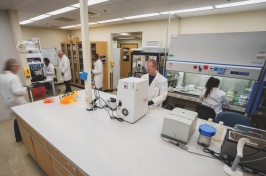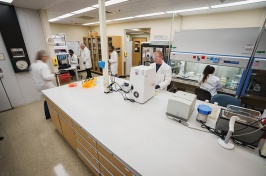Targeted Home Systems to Remove PFAS More Cost-Effective Than System-Wide Solutions

DURHAM, N.H. — PFAS, the potentially cancer-causing chemicals known as ‘forever chemicals’, have become an increasing concern in home drinking water. Solutions to reduce the risk of exposure range from mandated municipal-level water treatment to under-the-sink home treatment systems. But are consumers willing to foot the bill for an additional treatment system to help municipalities meet new federal drinking water regulations? Researchers at the University of New Hampshire found that they are, if it helps reduce the risk and fits their budget.
"The challenge with PFAS is that it's an insidious problem. It's everywhere, undetectable by our senses, and its health effects may not appear for decades," said Scott Lemos, senior lecturer at UNH's Peter T. Paul School of Business and Economics. "It is important to understand what consumers know and how much they are willing to pay to avoid potentially harmful exposure to PFAS, not just today but also years in the future."
In their study, published in the Journal of Water Resource Planning and Management, researchers found in the survey that households on public water systems are willing to pay an average of $156.84 annually ($13.07 on their monthly bills) to better protect themselves.
The study revealed that the average willingness to pay (WTP) falls short of covering municipal-level treatment costs and aligns more closely with the expenses of home water treatment systems, suggesting that system-wide PFAS treatments may not be appropriate on a local level, especially since PFAS contamination is more common in private wells.
“Instead of mandating an entire municipal water system to clean up the water, state and federal officials can test wells on a more localized basis in areas where PFAS pollution is a concern,” said Lemos. “If there's a problem with the water in the well, subsidize a reverse osmosis filter.”
Compared to the $156.84 annually WTP found in the study, an under-the-sink reverse osmosis filter costs approximately $500 and has a lifespan of around 10 years, resulting in an average annual cost of about $50, including maintenance, according to Lemos. When accounting for filter replacement and other upkeep, the yearly total cost is estimated at $100.
The survey also revealed higher willingness to pay among respondents who were younger, female, had children or expressed concerns about tap water safety.
PFAS (per- and polyfluoroalkyl substances) are manufactured chemicals used in industrial and consumer products. They have been linked to serious health issues like cancer, immune problems and reproductive issues, though their effects are still being studied. The chemicals gained attention in New Hampshire after contaminating drinking water wells at Pease Air Force Base in Portsmouth and the Saint-Gobain performance plastics plant in Merrimack.
Co-authors include John Halstead, UNH and Tristan Price, Maine Department of Environmental Protection.
Funding was provided by New Hampshire Agricultural Experiment Station.
The University of New Hampshire inspires innovation and transforms lives in our state, nation and world. Nearly 16,000 students from 50 states and 87 countries engage with an award-winning faculty in top-ranked programs in business, engineering, law, health and human services, liberal arts and the sciences across more than 200 programs of study. A Carnegie Classification R1 institution, UNH partners with NASA, NOAA, NSF, and NIH, and received over $210 million in competitive external funding in FY23 to further explore and define the frontiers of land, sea and space.
Latest News
-
June 16, 2025
-
June 6, 2025
-
May 15, 2025
-
May 14, 2025
-
May 14, 2025
















































